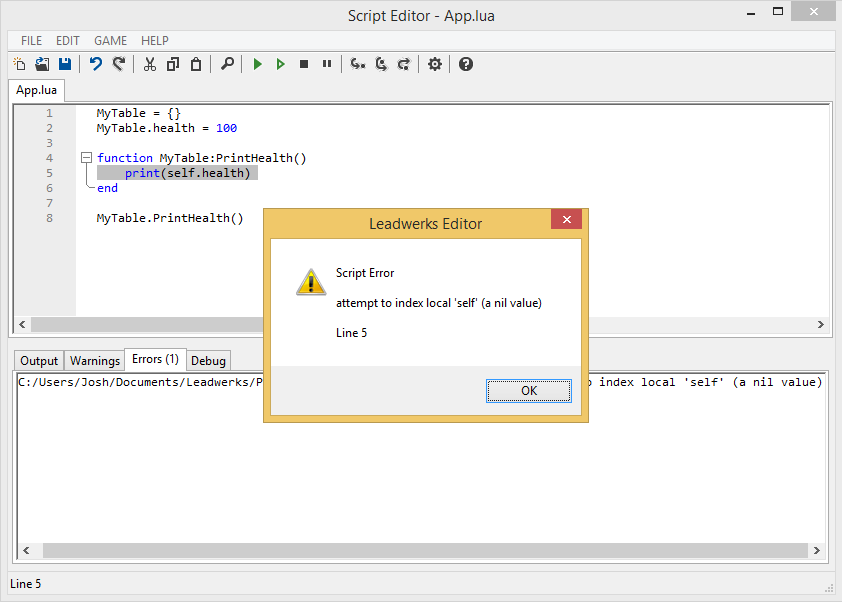Functions
Function Declarations
A function declaration looks like the code below:
function MyFunction()The function keyword indicates the start of a function declaration, and is followed by the name, which in this case is "MyFunction".  We can put any code inside the function.  The example below declares a function called "SayHello" which prints the string "Hello!" whenever it is called.  Note that the function code only gets called when the function is called.  The function code is not executafed before then::
--function code goes here.
end
function SayHello()
print("Hello!")
endSayHello()
Function Arguments
You can pass optional values to a function to be used in its code.  These values are called "arguments" or "parameters".  In the example below, a function is declared which accepts one argument and performs an action:
function PrintUpper(text)You can send multiple arguments to a function by separating them with a comma:
print(string.upper(text))
endPrintUpper("Functions can be fun.")
function CombineAndPrintUpper(text1,text2)
print(string.upper((text1))..string.upper((text2)))
endCombineAndPrintUpper("Hello, ","how are you?")
Return Values
Functions can also return a value to the code that is calling them.  The function below accepts an argument, adds one to it, then returns the result:
function AddOne(num)One special feature of Lua is that a function can actually return multiple values.  In the example below, two values are returned and assigned to two different variables:
return num+1
endn = AddOne(2)
print(n)
function AddOneAndSubtractOne(num)
return num+1, num-1
end--Whoa!
x,y = AddOneAndSubtractOne(2)print(x)
print(y)
Functions in Tables
Lua tables can have functions that allow them to act in an object-oriented manner.  This just means that the table can perform actions on its own values, instead of having to pass every single argument to each function.Declaring a table function is done like so
MyTable = {}function MyTable:SayHello()
print("Hello!")
endMyTable:SayHello()A table function is called with the table variable first, followed by a colon (":") and then the function name.  When a function is called in this manner, the table itself is accessible inside the function code with the keyword self.  In the next example, the keyword self is used to get the table's own "health" value and display it:MyTable = {}
MyTable.health = 100function MyTable:PrintHealth()
print(self.health)
endMyTable:PrintHealth()Note that the table variable and function name must be joined by a colon (":"), not a period(".").  Using the colon separator will silently insert the table itself into the "self" value.  If you use a period, the self variable will not be recognized in the function code:MyTable = {}
MyTable.health = 100function MyTable:PrintHealth()
print(self.health)
endMyTable.PrintHealth()When the above code is run, you'll get an error like this: If table functions look familiar, it's because you've already seen them, back in the first Lua tutorial.  The object scripts system Leadwerks uses makes use of table functions in this manner.  Do you remember adding this code to make the fan spin?
If table functions look familiar, it's because you've already seen them, back in the first Lua tutorial.  The object scripts system Leadwerks uses makes use of table functions in this manner.  Do you remember adding this code to make the fan spin?function Script:UpdateWorld()An object script has a table associated with the object in the map.  The self keyword refers to that table.  All object scripts have one table value that is always present called "entity".  This is the actual 3D object that gets loaded from the map, and it is always a type of Entity object.  So object scripts can always refer to their own entity with "self.entity".  You can add additional fields to this table for health, ammo, experience level, or anything else you want to make part of your game.  That, dear reader, is the power of Leadwerks and Lua.
self.entity:Turn(0,0,1)
end
Conclusion
Whoa!  Is your mind blown or what?  We've come full circle now.  The only thing left to do is wrap up a few more details and then it's on to the gameplay!